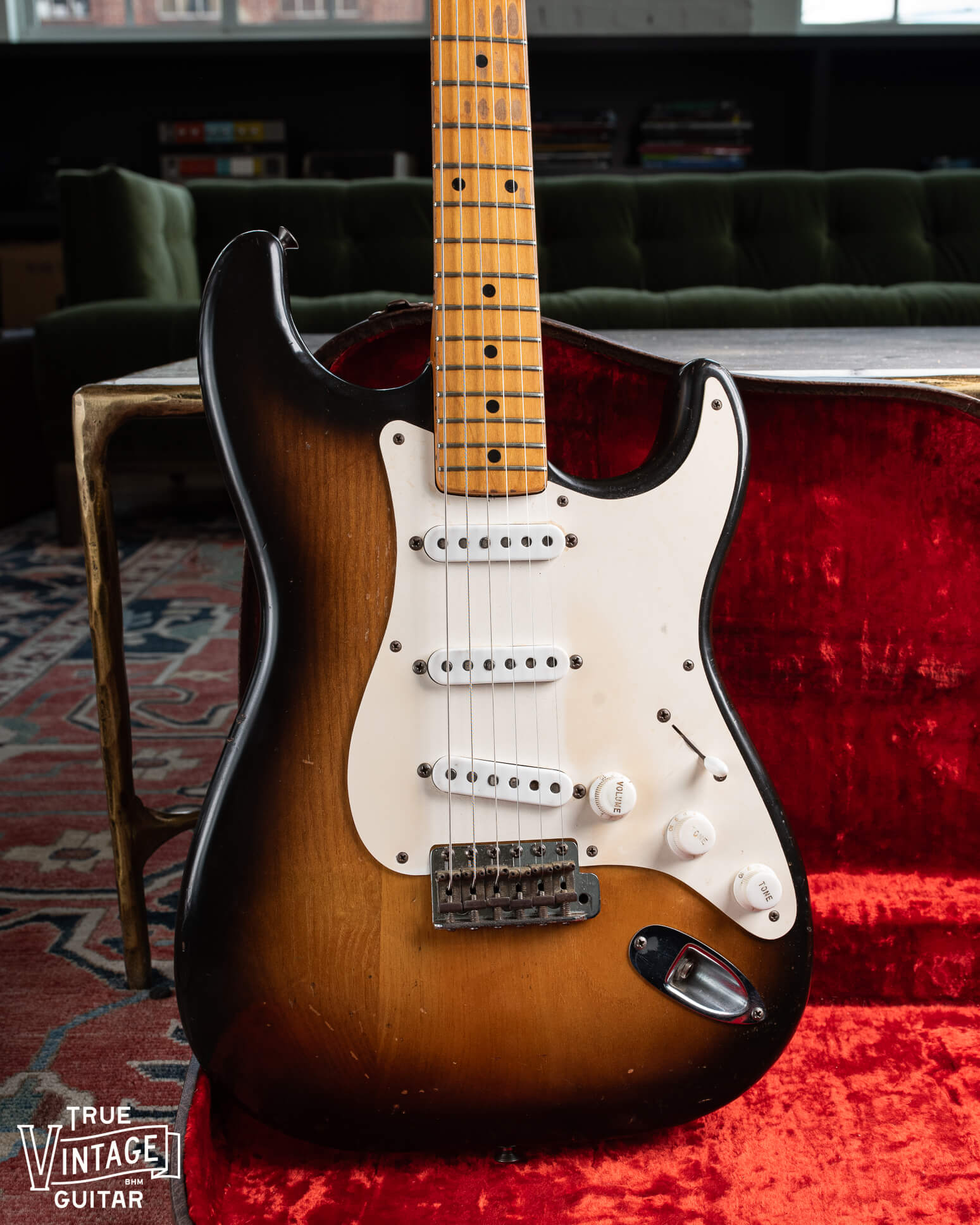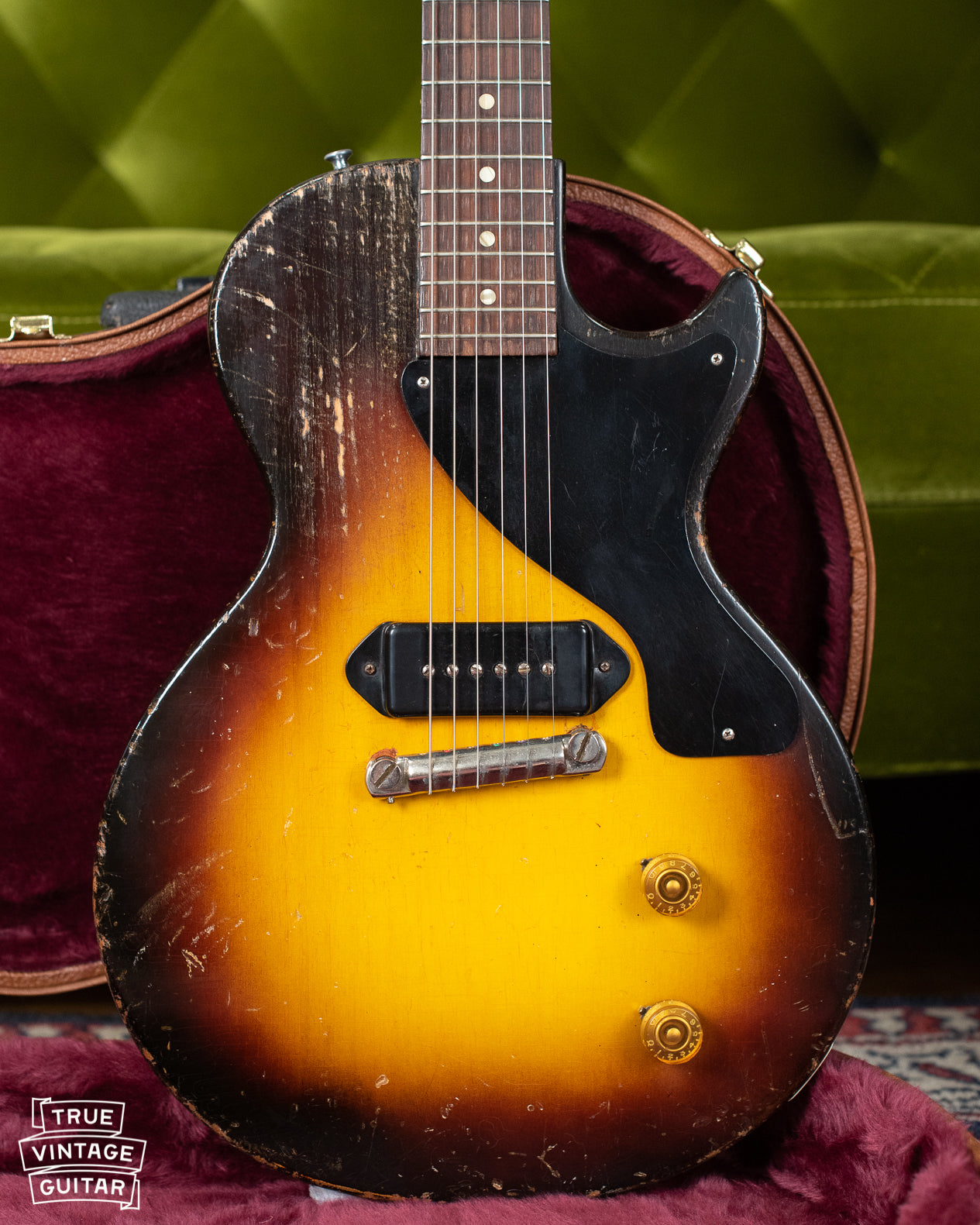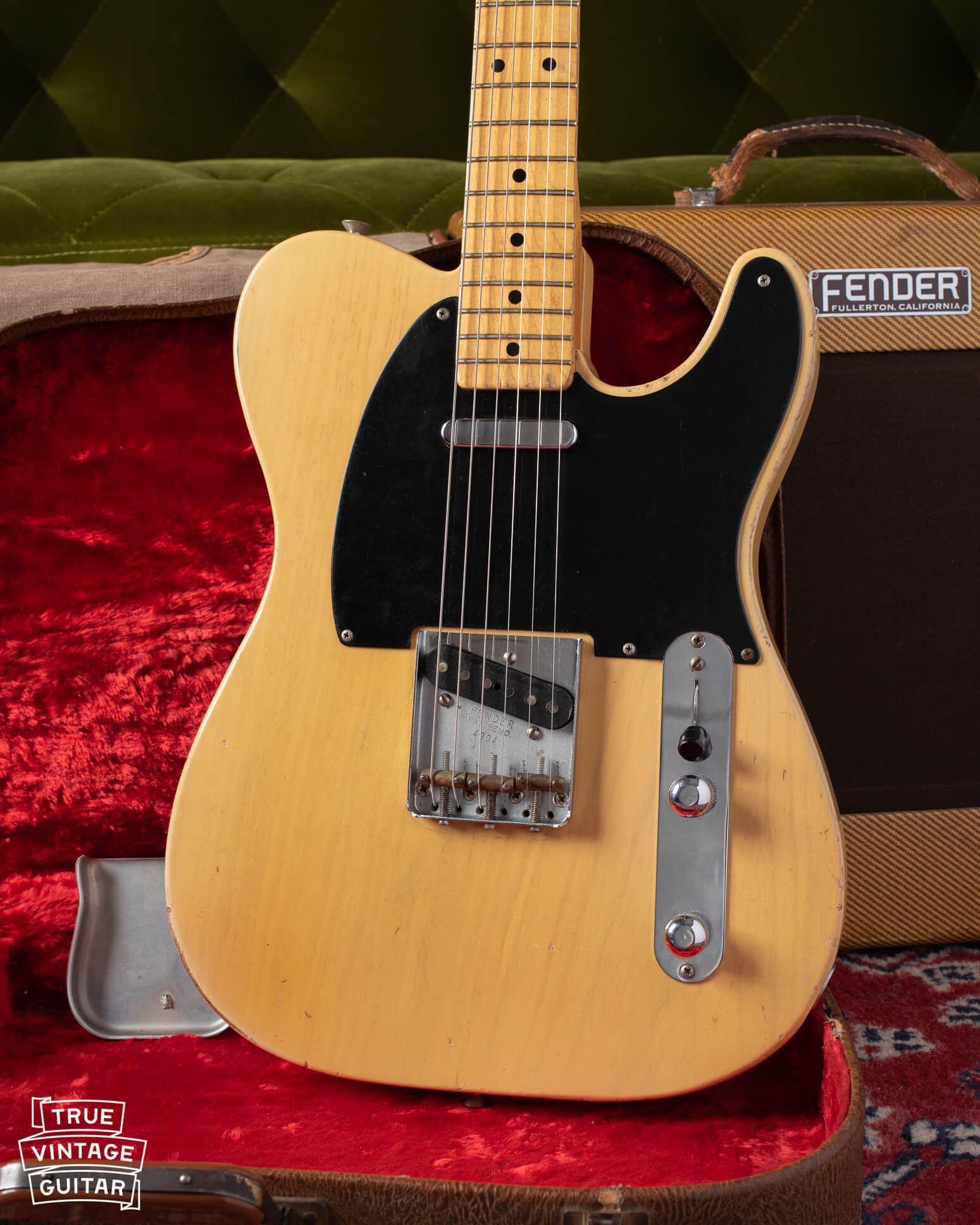Find the year and value of your Fender Stratocaster
This page is for owners of old Fender Stratocaster guitars looking for help identifying the year they were made. The value of your Strat depends heavily on the year it was made, so it's important to have an accurate date of manufacture. The information here will show you multiple ways to find out how old is your Stratocaster. I focus solely on vintage Stratocasters made during the 1950s and 1960s.
Here's how to date your Stratocaster: Read the serial number, check the neck and body dates, confirm with the potentiometer codes, and verify the timeline of features. Call us if you have a 1950s or 1960s Stratocaster: 659-208-7374.
Contact a Stratocaster Collector
I am a passionate guitar collector and am looking for Fender Stratocaster guitars from the 1950s, 1960s, and 1970s. I perform expert inspections on vintage Fender Stratocasters. I am also looking to acquire the nicest examples of all colors of Stratocasters made in the 1950s and 1960s. You can contact me here to sell a Fender guitar.
Date Your Stratocaster By Serial Number: Where to find the serial number on a Stratocaster and how to read it.
Stratocaster Neck Dates and Body Dates Where to find the neck and body dates and how they help date your Stratocaster
Date a Stratocaster by potentiometer codes The date code indicates in which year and week the part was made
Date a Stratocaster by features How important features like pickguards and fretboards help identify the year
1. Date your Fender Stratocaster by serial number
You can find the approximate year that your Fender Stratocaster was made by checking the location of the serial number and the range of known serial numbers from that year (Fender Serial Number Lookup). However, since Fender did not intend to use serial numbers to date guitars, looking up the serial number is only the first step in dating your guitar. It's best to check the serial number first then verify the year with steps 2 through 4.
Where to find the serial number on a Fender Stratocaster: Neck plate, front of the headstock, back of the headstock, neck heel, and tremolo cover plate. The chart below shows the possible locations for serial numbers and what years they were used.
We love vintage Fender Stratocasters: Sell a Fender.

Here is a comprehensive list if you're looking for how to date a Fender Stratocaster by serial number: Fender Serial Number Lookup. Fender Stratocaster serial numbers were applied to three different parts of the guitar from the introduction in 1954 until the 1980s: the tremolo cover plate on the back of the body (only for the first 200 Stratocasters in 1954!), the neck plate on the back (the most common location), and even the headstock at the top of the neck starting in the late 1970s.
How to read a Fender Stratocaster serial number: Check the location, exact number of digits, and reference the prefix. Stratocaster serial numbers were not date coded, but do have a prefix to indicate the year beginning in 1976.
Here is a timeline which shows how the Stratocaster serial number locations, styles, and prefixes changed from the introduction in 1954 until today:
Basic Stratocaster serial number timeline:
1954: First ~200 have serial numbers on the tremolo cover plate (very rare: contact me). The location moves to the chrome neck attachment plate in May of 1954.
1955 - 1963: Serial numbers consist of 5 digits, but some in 1957 and 1958 have a prefix of "0" or "-" for a total of 6 digits.
1963 - 1965: The prefix "L" preceeds 5 digit serial numbers until mid 1965
1965 - 1976: Serial numbers consist of 6 digits with a large stylized "F" underneath
1976 - Today: Since the late 1970s, Fender has utilized prefixes in front of the serial number to indicate the decade and sometimes the factory they were made in. Some examples include: "S" = Seventies, "E" = Eighties, "N" = Nineties, and so on.
The problem with dating a Fender Stratocaster using serial numbers alone is that they are often found on an easily replaceable part. Not only that, but these plates were not applied to guitars in a consecutive order. A lower serial number does not necessarily indicate an earlier guitar. Dating a Stratocaster by serial number is only the first step in getting a comprehensive view of what year your Fender guitar was made.

This guitar is an excellent example of why Fender serial numbers can be misleading. This Fender Stratocaster exhibited a lot features that indicated it was made in 1964. The serial number "1062", however, is from a range that indicates that it was made in 1954. The logo, style of finish, and veneer Rosewood fretboard indicated 1964, but the tuners, potentiometer codes, and tremolo cavity indicated 1954 and 1960. So what is this guitar?? Find out here: 1954, 1960, 1954 Fender Stratocaster.
2. Date a Stratocaster by Neck dates, Neck codes, body dates, and Masking Tape (expert technicians only)
Fender utilized various signatures and stamps on the bodies and necks of Stratocaster guitars to indicate what year and month they were made and by which employee. Stratocasters have two main date indicators: one signed in pencil or stamped on the heel of the neck and one pencil signed in the tremolo cavity on the back of the body (until about 1966 or so).
We love vintage Fender Stratocasters: Sell a Fender.
For expert technicians only: To check the stamp on the heel of the neck, detune the strings first so that there is no tension. Then, use a properly fitting screw driver to carefully unscrew the four bolts folding the neck plate to the body while supporting both the neck and the body. Most of the neck heels were signed with a month and year in pencil until 1962. After 1962, an ink stamp was used to stamp the model code, month, year, and neck width code. Here's what a neck heel stamp looks like:
1954 through 1956: Stratocasters made between 1954 and 1956 typically have inspector initials (XA or TG) and the date of inspection Month - Day - Year written in pencil
1956 through 1959: Strats during this period typically have only a pencil Month and Year
Mid 1959 through Mid 1960: These Strats typically have no neck heel date. There are rumors as to why, but I've not been able to confirm them with paperwork from Fender.
1960 through mid 1962: Fender went back to a pencil month and date until mid '62
1962 through 1969: Strats in the 1960s typically have a black ink stamp neck heel date with a model code, month, year, and a neck width code. The model code can sometimes look like a day, but "2" or "13" are codes for the Stratocaster model! Stamp code: first digit(s) are the model code, then month code, year code, then neck width.
2 or 13 = Stratocaster model
MAR = March (JAN = January, FEB = February, etc)
62 = 1962
B = standard neck width 1 5/8" (A = 1.50", C = 1.75", D = 1.88")
1969 through 1972 (Green stamp): The green stamp is difficult to decipher, but the important part is the last digit or digits before the neck width code. These refer to month and year of production in a (M)MY format (M = month of the year out of 12, and Y = last digit of the year. The first digit refers to the model code (13 = Stratocaster)

This neck heel date stamp reads "2SEP65B" which should read accordingly: "2" = Stratocaster model (not the day!), "SEP" = September, "65" = 1965, "B" = standard nut width or 1 5/8". It's tempting to think that the first number may represent the day, but it actually is a model code that indicates what model the neck is intended for.
Here's an example of a tremolo cavity pencil signature date indicating it was made during July of 1960:

3. Date with potentiometer codes:
The next step I take during an expert inspection of a Stratocaster to find the year it was made is to remove the pickguard and inspect the electronics (for expert technicians only). The potentiometers are the variable resistors that allow the player to adjust the volume and tone of the guitar through the amplifier. Potentiometers are made with manufacturer codes that indicate the manufacturer and what week of what year it was made. Here's an example that reads "137_6510" which would indicate Chicago Telephone Supply (137), 1963 (63), and the 46th week (46). This Stratocaster was made in 1963.
We love vintage Fender Stratocasters: Sell a Fender.
6 digit potentiometer code: "AAA BCC" A = manufacturer code, B = last digit of the year (1940s or 1950s typically), and C = week of the year. Example: 304 701 is a potentiometer made by Stackpole during the first week of 1957
7 digit potentiometer code: "AAA BBCC" A = manufacturer code, B = last two digits of the year, and C = week of the year. Example: 304 6043 is a potentiometer made by Stackpole during the 43rd week of 1960

4. Stratocaster Year by features:
It takes a skilled guitar collector's eye to date a Fender Stratocaster by its exterior features, but many of us can do it only a few seconds. The important things that I look for are the logo style, fretboard style, finish style and color, and even the case color and style. Many of these aspects changed as production continued through the 1950s, 60s, and 70s which makes dating them a bit easier and quicker than taking them apart.
We love vintage Fender Stratocasters: Sell a Fender.
Peghead logos 1954 - 1965: The Stratocaster logo decal on the headstock had no patent numbers from 1954 to 1961. In '61, two patent numbers were added below the model name. A third patent number was added in '62, then a forth in 1964.

You can contact me at the red button in the lower right of your screen if you'd like guitar expert's help with your guitar. I can help with a vintage guitar appraisal for insurance purpose if you like. I'm also looking to buy vintage Fender Stratocaster guitars from the 50s, 60s, and 70s.
Frequently Asked Questions about dating Stratocasters
Q: What are the best years for the Fender Stratocaster?
A: I have found that the best Strats were made during the 1954 through 1965. Your specific favorite year of the Strat likely depends on your preferences. If you like Maple fretboards, then your choices are 1954-1959, or a select few custom examples in the 1960s. If you like the slab Rosewood fretboard then you'll want to find one made from 1959-1962. If you prefer Brazilian Rosewood over Indian Rosewood then you'll want to find one made between 1959-1964.
We love vintage Fender Stratocasters: Sell a Fender.
Q: What year is the most desirable Stratocaster?
A: 1954. There are three levels of value for 1954 Stratocasters: Spring, Summer, and late. Stratocasters from the Spring of 1954 are the most rare and desirable.
Q: What year was the Stratocaster first released?
A: 1954. Fender debuted the Stratocaster model in the spring of 1954. The model was in development beginning during the summer of 1953.
Q: How old is my Stratocaster?
A: If all the parts are original to your guitar, then you can check Fender Serial Numbers or the different parts of this page.




Comments
Hello, I picked up a Fender Stratocaster with serial number S984371 on the headstock and a big S M on the face of the bottom of the neck with 90•8•15 on the butt of the bottom of the neck. 1979ish? Or 1990? Thank you
I acquired a strat in 1980, and it was a used guitar, but looked new. In that year I immediately replaced the bridge pickup with a humbucker by simply cutting off part of the plate. So the pickup itself goes back to 1980, this is the only modification that was made. Does that modification change the value even if it was done in 1980? I still don’t know the original date of this guitar. I may want to sell it. By the way , it has a maple neck.
HI. I recently tried to sell my Fender but the prospective buyer could not validate the guitar useing Fenders own website. The serial no. is on the headstock and is E800099. It is a two toned American stratocaster with original fender hardcase.
Thanks in advance.
Simon.
Have a 1967 Fender Stratocaster. My dad played music for years and years. He passed away and all his old equipment was in his spare room. We are looking to sale the Fender in case. My phone number is 907.978.6383
Hi,
was wondering if there’s a way to know just how many Fender guitars were made in a particular year. I have a 1959 Jazzmaster with the anodized pick guard and I am curious as to how many of those guitars,(in 1958-59 W/anodized pick guard) were actually made. I hear they’re fairly rare. Thanks in advance, for any info. you might have for me. :)
Cheers,
Scott
Hi,
I’m looking at purchasing a 1974 Strat however I am concerned about the neck which dates to 1972.
Everything about the guitar checks out including the electronics and neck plate serial number.
Have you ever come across a vintage strat with a different neck/body serial numbers?
Any help would be greatly appreciated.
Many thanks
Michael
I have a stratocastor with a case and book, it seems old ,the serial is 027950